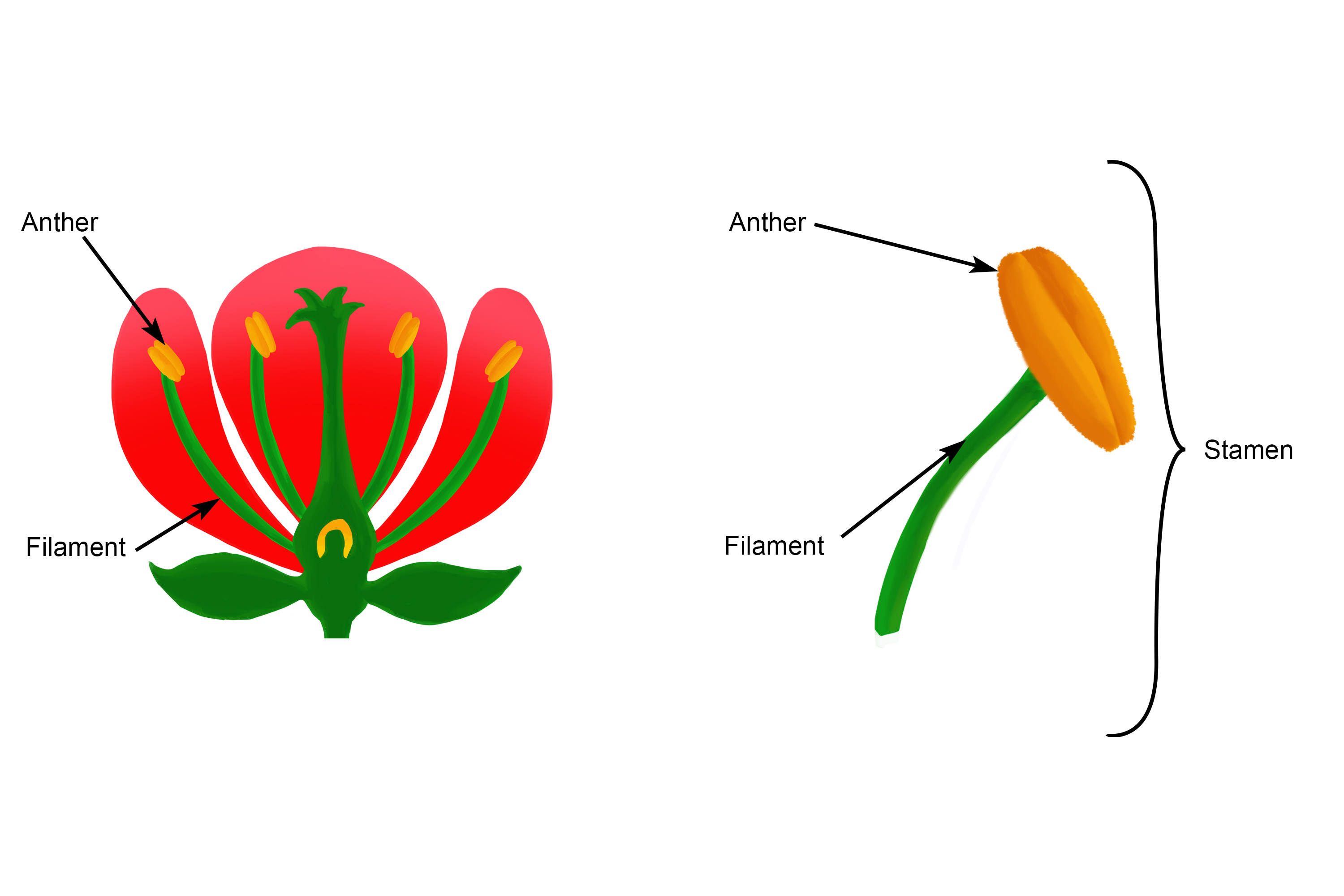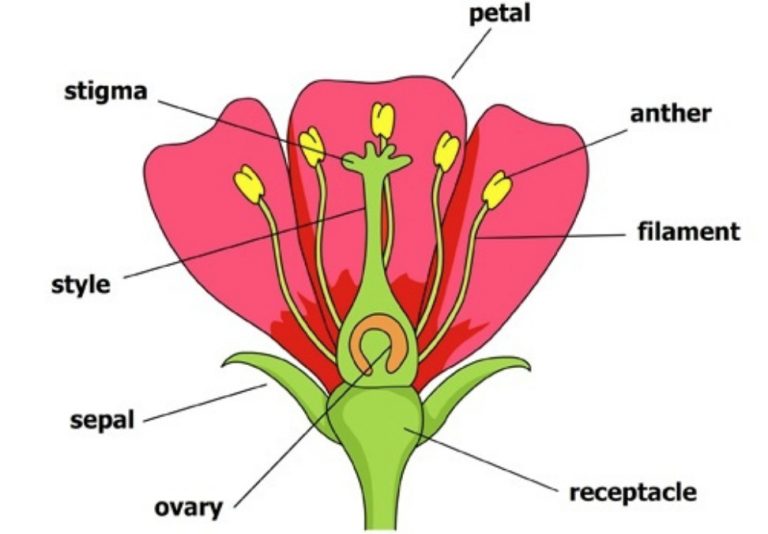The Stamen: A Tiny Titan of Plant Reproduction

The stamen, often overlooked in the grand spectacle of a blooming flower, is a critical component in the plant world’s reproductive machinery. This unassuming structure, typically slender and often topped with a pollen-laden anther, is responsible for producing and delivering the male gametes, or pollen, that are essential for fertilization and the continuation of plant life. Understanding the stamen’s structure, development, function, and variations is crucial for comprehending the intricate processes of plant reproduction and the remarkable diversity of flowering plants.
Anatomy of the Stamen: A Two-Part System
The stamen, in its simplest form, consists of two main parts: the filament and the anther.
The Filament: The filament is the stalk-like structure that supports the anther. Its primary function is to elevate the anther, positioning it in a location that facilitates pollen dispersal. The length of the filament can vary significantly between species and even within a single flower. This variation plays a crucial role in pollination strategies, ensuring that pollen is presented effectively to pollinators or carried efficiently by wind or water. The filament is typically composed of vascular tissue (xylem and phloem), which provides the anther with water and nutrients necessary for pollen development.
The Anther: The anther is the pollen-producing part of the stamen. It is usually a bilobed structure, meaning it consists of two distinct halves, or thecae, connected by a connective tissue called the connective. Each theca contains two microsporangia, also known as pollen sacs, where pollen grains develop. Within these pollen sacs, specialized cells called pollen mother cells undergo meiosis, a type of cell division that reduces the chromosome number by half, resulting in haploid microspores. These microspores then mature into pollen grains, each containing the male gametophyte.

The Journey of Pollen: From Microspore to Mature Grain
The development of pollen within the anther is a complex and carefully orchestrated process:

Microsporogenesis: The journey begins with the pollen mother cells within the microsporangia. These diploid cells undergo meiosis, dividing into four haploid microspores. This reduction in chromosome number is essential for sexual reproduction, ensuring that the resulting offspring have the correct number of chromosomes.
Microgametogenesis: Each microspore undergoes a further transformation. The nucleus of the microspore divides mitotically (a type of cell division that preserves the chromosome number) to produce two cells: the generative cell and the tube cell.
Pollen Grain Formation: The microspore develops a protective outer wall, known as the exine, which is composed of sporopollenin, a highly resistant biopolymer. The exine provides structural support and protects the pollen grain from environmental damage, such as desiccation and UV radiation. The exine often exhibits intricate patterns and ornamentation that are species-specific, aiding in pollen identification.
Pollen Maturation: The generative cell may divide again before pollen dispersal to form two sperm cells. The mature pollen grain, now containing either a generative cell and a tube cell or two sperm cells and a tube cell, is ready for release from the anther.

Pollen Release: Dehiscence and Dispersal
The process by which pollen is released from the anther is called dehiscence. This usually involves the drying and splitting of the anther along predetermined lines of weakness. The mechanism of dehiscence varies depending on the plant species, but it often involves the differential drying of specialized cells within the anther wall, causing it to rupture.
Once released, pollen grains must be transported to the stigma, the receptive surface of the pistil (the female reproductive organ of the flower). This process, known as pollination, can occur through various agents:
Wind Pollination (Anemophily): Plants that rely on wind pollination typically produce large quantities of lightweight, dry pollen grains that are easily carried by air currents. These plants often have inconspicuous flowers with reduced petals and sepals.
Insect Pollination (Entomophily): Insect-pollinated plants often have brightly colored and fragrant flowers that attract insects. These flowers may also offer rewards, such as nectar or pollen, to entice insects to visit and transfer pollen. Pollen grains of insect-pollinated plants are often larger and stickier than those of wind-pollinated plants.
Animal Pollination (Zoophily): Some plants rely on other animals, such as birds, bats, or even small mammals, for pollination. These plants often have specialized floral adaptations that cater to their specific pollinators.
Water Pollination (Hydrophily): Plants that grow in aquatic environments may rely on water to transport their pollen. Pollen grains of water-pollinated plants are often adapted to float on the water surface or remain viable underwater.
Variations in Stamen Morphology: A Reflection of Evolutionary Adaptations
The morphology of the stamen can vary significantly among different plant species, reflecting adaptations to different pollination strategies and environmental conditions. Some notable variations include:
Number of Stamens: The number of stamens in a flower can vary from a single stamen to hundreds, depending on the species. The number of stamens is often a characteristic feature used in plant identification.
Stamen Arrangement: The arrangement of stamens within the flower can also vary. In some flowers, the stamens are arranged in a single whorl, while in others, they are arranged in multiple whorls.
Stamen Length: The length of the stamens can also vary, influencing the positioning of the anthers and the effectiveness of pollen dispersal.
Adnation and Cohesion: Stamens can be fused to other floral parts (adnation) or to each other (cohesion). For example, stamens may be fused to the petals (epipetalous) or to the pistil (gynostemium). Stamens can also be fused together by their filaments (monadelphous) or by their anthers (syngenesious).
Staminodes: In some flowers, certain stamens may be sterile and lack functional anthers. These sterile stamens are called staminodes. Staminodes can serve various functions, such as attracting pollinators or producing nectar.
The Significance of the Stamen: More Than Just Pollen Production
The stamen plays a crucial role in plant reproduction, but its significance extends beyond simply producing pollen. The stamen contributes to:
Genetic Diversity: The process of meiosis during pollen development ensures that each pollen grain carries a unique combination of genes. This genetic variation is essential for the adaptation of plants to changing environments.
Food Security: Pollen grains are rich in nutrients and serve as a food source for many insects and other animals. The availability of pollen is crucial for the survival of these pollinators, which in turn are essential for the pollination of many crops.
Human Health: Pollen grains can trigger allergic reactions in some individuals, causing hay fever and other respiratory problems. Understanding the structure and composition of pollen grains is important for developing strategies to mitigate these allergic reactions.
FAQ about the Stamen
Q: What is the difference between the stamen and the pistil?
A: The stamen is the male reproductive organ of a flower, responsible for producing pollen. The pistil is the female reproductive organ, responsible for receiving pollen and developing into a fruit containing seeds.
Q: What is the function of the filament?
A: The filament supports the anther, elevating it to a position that facilitates pollen dispersal.
Q: What is the exine made of?
A: The exine is made of sporopollenin, a highly resistant biopolymer that protects the pollen grain from environmental damage.
Q: What is dehiscence?
A: Dehiscence is the process by which pollen is released from the anther.
Q: What are staminodes?
A: Staminodes are sterile stamens that lack functional anthers.
Q: How does the stamen contribute to genetic diversity?
A: The process of meiosis during pollen development ensures that each pollen grain carries a unique combination of genes.
Q: Why are pollen grains important for food security?
A: Pollen grains are a food source for many pollinators, which are essential for the pollination of many crops.
Conclusion: A Vital Component of Plant Life
The stamen, though often small and unassuming, is a vital component of plant reproduction. Its intricate structure and complex development ensure the production and delivery of pollen, the male gametes that are essential for fertilization and the continuation of plant life. The variations in stamen morphology reflect the remarkable diversity of flowering plants and their adaptations to different pollination strategies and environmental conditions. Understanding the stamen is crucial for comprehending the intricate processes of plant reproduction and the vital role that plants play in our ecosystem and our lives. From ensuring genetic diversity to supporting food security, the stamen’s contributions are far-reaching and essential for the health and well-being of our planet. So, the next time you admire a beautiful flower, take a moment to appreciate the often-overlooked stamen, a tiny titan of plant reproduction.

